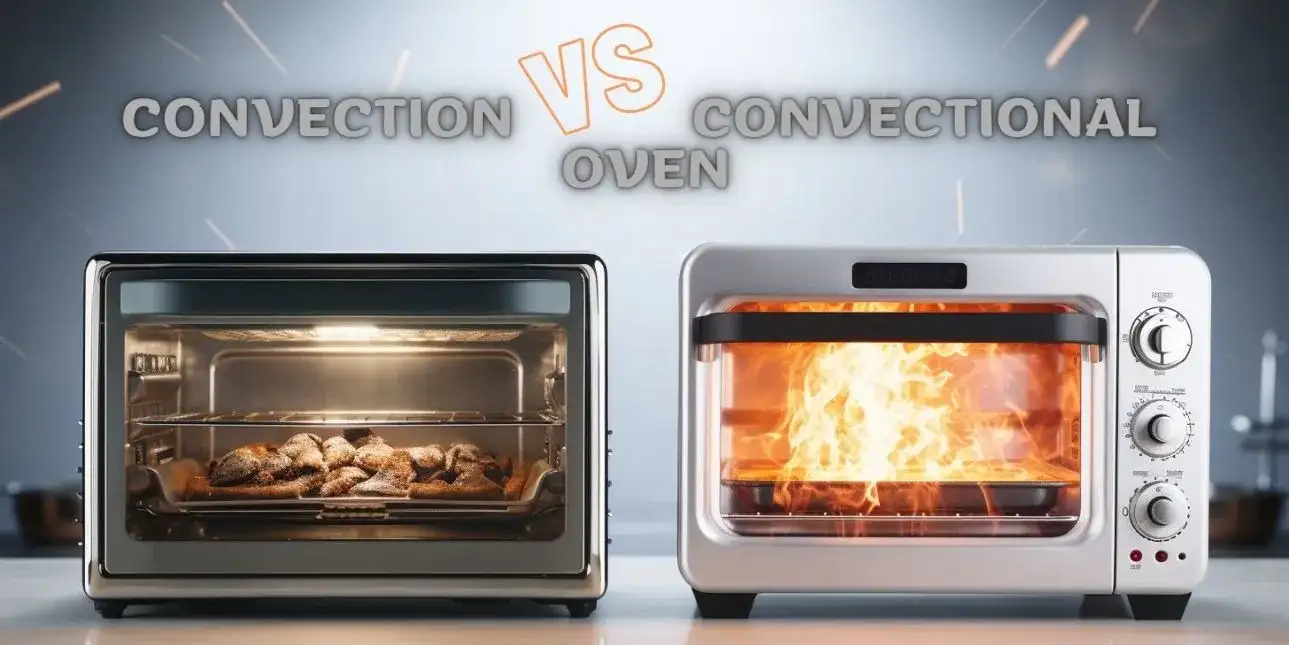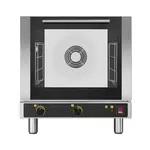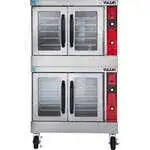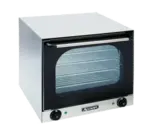
The Difference Between Convection vs Convectional Oven
Choosing between convection and conventional oven models can be complicated if you need to replace aging ovens or expand your kitchen. Each offers trade-offs that impact performance, costs, and menu flexibility differently.
For a restaurant owner, selecting the right oven technology is about more than just features; it is about ensuring food maintains consistent quality, the kitchen operates efficiently, and costs remain under control. Knowing the key differences between convection and conventional ovens can help make the choice that best suits the menu, cooking style, and budget.
This guide will demonstrate the key differences between convection and conventional ovens in simple, practical terms, uncovering their features and benefits to determine which oven reigns supreme in this showdown!
What is a Convection Oven?
A convection oven is an electric equipment that utilizes a fan to circulate hot air around the food. The circulating hot air provides more consistent heat exposure to the food from all sides, allowing for shorter cooking times, more even browning, and crisping.

Convection ovens tend to have more consistent temperatures than conventional ovens since the airflow helps distribute and equalize the heat. They also work well for different recipes that may otherwise cook at different rates, such as:
- Cookies and biscuits: The circulating hot air helps bake cookies and biscuits evenly without overbaking the edges.
- Roasted chicken: Roasting a whole chicken in a convection oven is superb. The hot air circulates inside the cavity to cook the bird evenly and quickly, crisping the skin beautifully.
- Casseroles: Baked pasta, rice, and other casseroles cook more evenly in a convection oven.
- Pizza: Pizza bakes up amazingly well in a convection oven. The circulating hot air helps crisp the crust while melting and evenly cooking the toppings.
Commercial convection ovens are expensive due to their larger size, higher wattage heating elements, and ability to handle heavier usage. For instance, a basic commercial convection oven for a restaurant can cost $800 to $3,000, while larger units suitable for high-volume restaurants can range from $5,000 to $10,000 or more.
While more expensive initially, commercial convection ovens can help restaurants reduce labor costs, improve food consistency and increase throughput, justifying the higher price tag over time.
How To Use A Convection Oven?
Using a convection oven is slightly different than a regular oven. While the basic concept is simple, a few techniques exist to get the most out of the convection oven.

Preheat the oven
Always preheat the convection oven for 10 to 15 minutes before baking to allow the circulating air and heating elements to reach the desired temperature; this ensures food will cook properly from the start.
Adjust cooking time and temperature
Cooks will likely need to lower the temperature by 25 to 50 °F and reduce the cooking time by 10% to 25% compared to non-convection recipes. The hot air circulates more efficiently, so food cooks faster at a lower temperature. Start by adjusting the temperature first, then check the food a few minutes early to ensure it does not overcook.
Use the right cookware
Use oven-safe cookware with low, straight sides that allow air to circulate the food. For example, dark, heat-absorbing materials are durable enough to withstand higher temperatures and have a surface that allows air to circulate freely around the food.
Arrange the food properly
Space items on pans so hot air can flow freely around each. Do not crowd or overlap items. In addition, rotate pan positions halfway through cooking to ensure even baking.
Make use of the convection setting
Use the convection setting or function whenever possible for the fastest, most even results; this automatically switches the fan to high and optimizes the temperature for convection cooking.
Monitor the cooking process
Keep an eye on food as it cooks faster than normal. Check it early and extend the time if needed. Use an oven-safe thermometer to ensure food has reached the proper internal temperature.
What is a Conventional Oven?
An essential appliance in bakery equipment, the conventional or regular oven relies solely on radiant heat from the heating elements, usually made of metal coils, to cook food. Therefore, it does not have any fan system circulating air inside it.

The heat comes from the bottom or top of the oven to create hot air movement. However, the air is not evenly distributed throughout the cavity, as areas directly above the heating elements may cook faster than other spots.
This results in noticeable hot and cold zones in different oven parts. For instance, food placed in a cold spot won’t cook as fast and evenly. Hence, conventional ovens are simple but do not provide the most uniform heating.
In general, recipes that need slow, gentle cooking over a longer time tend to do better in the more temperate environment of a conventional oven compared to the faster, hotter air circulation of a convection oven, such as:
- Large roasts: Large cuts of meat like standing rib roast, prime rib, or whole turkey benefit from the gentler, more enclosed heat of a conventional oven. The natural convection helps cook the meat evenly while building a flavorful crust.
- Pot roasts: Slow-cooked braised meals like pot roast, stew meat, and chili work best in a conventional oven. The steady, surrounding heat gently cooks the tougher cuts until fork-tender without drying out the meat.
- Sheet pan dinners: One pan meat and vegetable dinners roasted on a sheet pan work well in conventional ovens. The natural air circulation still helps the food cook evenly, though not as quickly as in a convection oven.
- Custards: Baked custards, like crème brûlée and flan, are best cooked in a conventional oven. The gentle heat lets the mixture set properly without curdling or overcooking the edges first.
Commercial standard or conventional ovens for restaurants cost less than convection ovens of similar size due to the simpler design without a fan. For example, a small commercial conventional oven can range from around $600 to $2,000, while larger units can cost $3,000 to $7,000.
Therefore, for some restaurants, especially those focused more on manual cooking skills or with lower volumes, conventional ovens may provide good performance at a lower price.
What Are The Benefits Of A Convection Oven vs. Conventional Oven?
Now let us compare some of the benefits of convection ovens and where they outperform traditional ovens:

The Convection Oven Benefits
- Faster cooking: The circulating hot air cooks food quicker than a conventional oven, saving time and energy.
- More even results: No more cold or hot spots. The consistent heat distribution gives perfectly consistent cooking.
- Ideal for baking: The dry, moving air creates a great environment for baking. Cooks will get crispier cookies, pizza, fries, etc.
- Multitasking ability: You can cook multiple items on different oven racks with great results thanks to the all-around heat.
- Moisture retention: Foods do not dry out as quickly, so meats stay juicier. The increased airflow does remove some moisture, but shorter cook times prevent foods from drying out.
- Self-cleaning: High-end models have pyrolytic self-cleaning, which turns food residue to ash at high heat thanks to the built-in fans circulating the hot air.
Conventional Oven Benefits
- More affordable: Conventional ovens are typically cheaper than convection models, especially when comparing basic units.
- Intuitive to use: There is no learning curve since you use them just like a traditional oven. Recipes also do not require adjustment.
- Gentler cooking: The radiant heat is less harsh and intense than convection. Hence, it is good for delicate dishes.
- Versatile: Cooks can use any type of cookware, including ceramic and glass dishes, which are not recommended for convection ovens.
Differences Between Convection and Conventional Ovens
Let’s quickly recap the main differences between the two oven types:
| Convection Oven | Conventional Oven |
| Has a fan that circulates hot air | Relies solely on radiant heat from elements |
| Cooks food faster | Standard cooking times |
| More energy efficient | Less energy efficient |
| It provides very even heating | It has hot and cold spots |
| Good for baking crispy foods | Better for delicate dishes |
| Ideal for multi-rack cooking | Works best for single rack |
| Requires adjusting temperature and time | No recipe adjustment needed |
| Best for metal cookware | Works with any bakeware |
| Usually more expensive | Typically more budget-friendly |
To Wrap Up!
When choosing between convection vs. conventional ovens, there are valid pros and cons to weigh. Ultimately, convection ovens win out in terms of cooking power and performance. However, these benefits come at a premium price.
Conventional ovens, on the other hand, offer a simpler, more classic baking experience. Their radiant heat might not be as precise, but it can still yield delicious results. A standard oven does the job for gentler cooking with no learning curve.
A convection model is superior if your menu requires perfect uniformity, faster baking times, and multiple pans. The circulating hot air creates the ideal environment for consistent results across batches. Whichever oven best fits your kitchen needs and budget is the right choice!
FAQ
What is a convection oven used for?
A convection oven is great for baking tasks like cookies, pizza, fries, roasting meats, and veggies. It cooks food fast and crispy. The even heating allows for using multiple racks.
Is a convection oven better than a conventional one?
In most cases, yes. Convection ovens provide faster, more consistent cooking results. The only downside is they run more expensive, whereas conventional ovens are fine for basic baking on a single rack.
Can a convection oven replace a conventional oven?
Absolutely. Cooks can use a convection oven for all the same tasks as a conventional model. They just need to adjust the temperature and time to account for the fan.
When should you not use a convection oven?
It is best to avoid convection cooking for delicate foods like custards or souffle that need gentle heat. The intense airflow can cause them to overcook or collapse.
What can you cook in a conventional oven?
Conventional ovens are well suited for cooking meals that benefit from steady, even heat over a long period. They excel at roasting larger cuts of meat, braising tough cuts until tender, and making custards and bread that require gentle heating.




